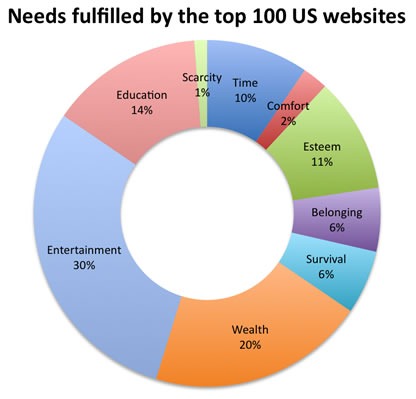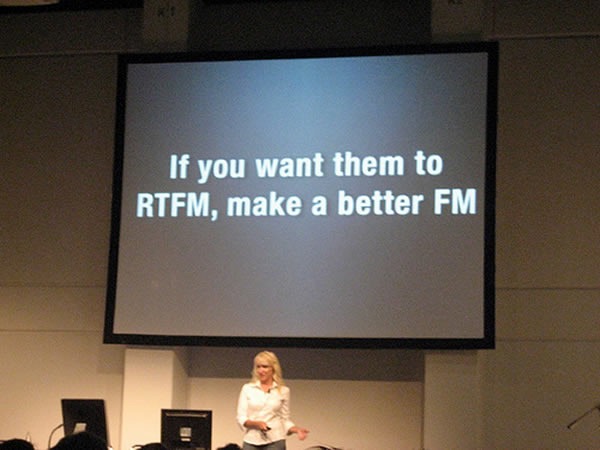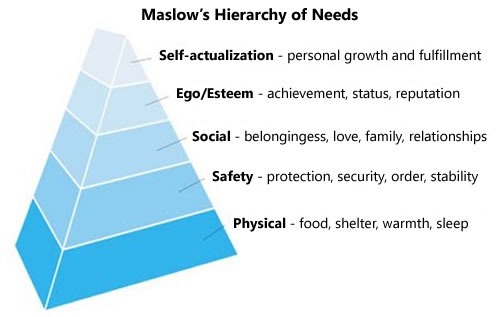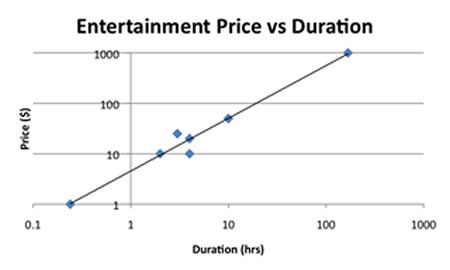Sound advice from Kathy Sierra (pictured giving one of those mind-blowing presentations that are her stock in trade). Her blog, Creating Passionate Users, while dormant, is still worth reading.
Tag: user-centric design
Don’t have Silverlight? Get it here or download the video in
MP4, WMA, WMV, WMV (High) or Zune format.
Welcome to another installment of Counting Down to Seven, a series of articles about mobile app development that I’m writing as we count down the days to MIX10, when we reveal more about the up-and-coming Windows Phone 7 Series.
 We’re a week away from the start of the MIX10 conference! I like to refer to this as Microsoft’s most “right-brained” gathering, as its target audience and topic isn’t just developers and writing software, but designers, design and user experience.
We’re a week away from the start of the MIX10 conference! I like to refer to this as Microsoft’s most “right-brained” gathering, as its target audience and topic isn’t just developers and writing software, but designers, design and user experience.
With designers and design in mind, it’s only fitting that I show you a video featuring Nic Fillingham interviewing a couple of Microsoft User Experience gurus who also hail from Canada:
- Bill Buxton: He’s a Principal Researcher for Microsoft Research, and before that, he was Chief Scientist at Alias Wavefront and a professor at University of Toronto. And I’m pleased to report that he got his bachelor’s degree – in music – from my alma mater, Crazy Go Nuts University (which some of you may know as Queen’s University). He was the guy who thought of applying Fitts’ Law to human-computer interaction, did some pioneering work with multi-touch interfaces and invented the pie menu (which means that we owe weapon selection in Saints Row 2 and the full combat/spellcasting system in Dragon Age: Origins to him).
- Albert Shum: He’s the Director of Mobile Experience Design for Windows Phone 7. Albert’s from Winnipeg, studied engineering and architecture at University of Waterloo and went on to do design work at Nike before joining Microsoft. You can watch a video showing him talking about the new Windows Phone 7 experience and the thinking behind it in a previous article of mine, Albert Shum on Windows Phone 7.
If you’ve taken a psychology course or have leafed through a user experience book, you’ve probably come across a diagram of Maslow’s Hierarchy of Needs:
Dan Zambonini of the web development shop Box UK took some inspiration from it and wrote an article titled Web App Business Models: User Needs and What People Pay For. In it, he writes:
As customers, we have a finite number of needs that we’re willing to fulfill by parting with our hard-earned cash. If you’re planning a web application that can’t build a business model around one or more of these needs, you may face difficulties generating sustainable revenue.
He breaks down people’s needs into the following categories, with an explanation of each one:
- Time: Convenience, Efficiency, Immediacy
- Scarcity
- Comfort
- Esteem: Id, Desirability, Self-Image, Ego
- Belonging: Relationships, Sex, Affection
- Survival: Health, Safety, Wellbeing
- Financial Security: Wealth, Success, Career
- Entertainment: Emotion, Experiences
- Intellectual Stimulation: Creativity, Learning, Expression
He also looks at how much people are willing to have different needs fulfilled. For example, people are willing to pay geometrically increasing prices for increasing comfort. Consider the 15x price difference between “cattle class” and first-class tickets on an airplane (even though both depart and arrive at the same times), or the 27x price difference between a bargain-basement pillow and a down-filled one:
Entertainment, on the other hand, is a different beast. According to Zambonini, across the wide array of entertainment options from games for their mobile phones to vacations in the tropics, people are willing to pay the same rate: $5 an hour…
He categorized the top 100 U.S. sites by the needs he listed — here’s how they break down:

Naturally, such categorization is subjective and had to be drastically simplified, with each site being slotted into a single category. Sites about food were put into the “survival” category, even though a top 100 site on food would probably cover things like gourmet food and wine, which could arguably be put into the “entertainment”, “comfort” and even “esteem” categories.
He closes the article with a series of questions that you should ask about your application, such as “Does my app allow the user to do something more quickly?”, “Does my app allow the user to express their creativity?”, “Does my app provide entertainment for the user?” and so on. Your should be able to answer “yes” to at least one of these questions, and better still, you should be able to explain why.
Links
- Web App Business Models: User Needs and What People Pay For
- Better Than Free: In it, Kevin Kelly “discusses the concept of ‘Generatives’: non-copyable qualities that retain value in a digital age.”
- Wikipedia page for Maslow’s Hierarchy of Needs
- Follow Dan Zambonini on Twitter
This article also appears in Canadian Developer Connection.
Just in case there’s nothing good on TV and you’re having a “lazy Sunday”, here’s a video of Joel Spolsky’s recent presentation at Google, Learning from StackOverflow.com, in which he talks about the design decisions that went into and the lessons learned from the Stack Overflow site. It runs for about 52 minutes, so you might want to get yourself a nice beverage before you watch it:



